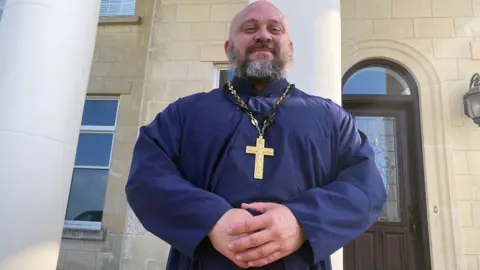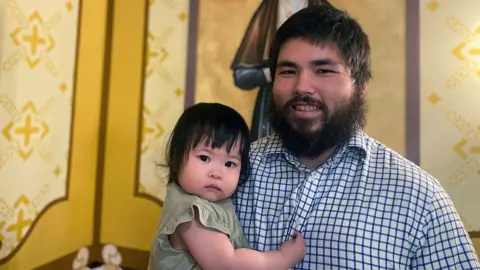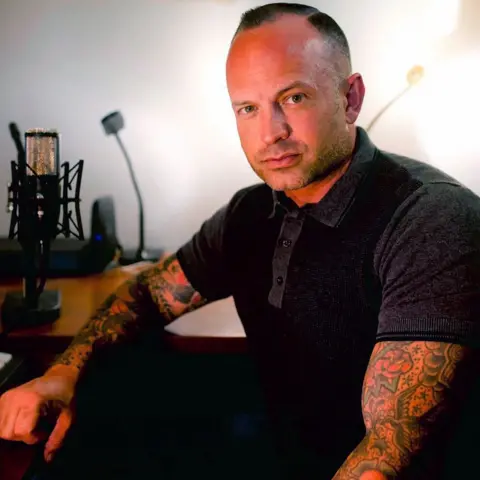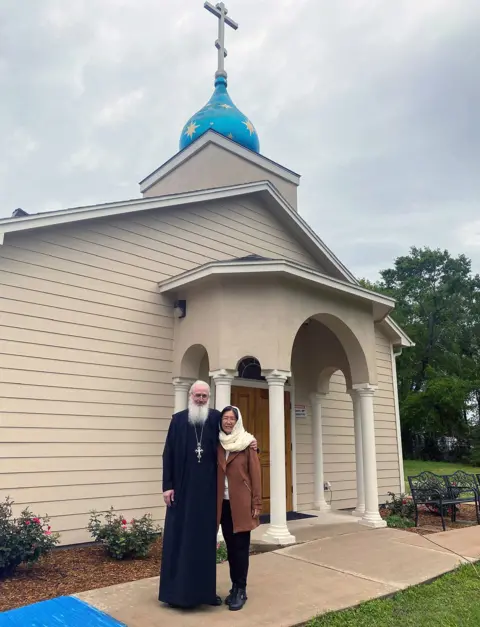 Bbc
Bbc“Many people ask me:” Father Moses, how can I increase my virility at absurd levels? “”
In a YouTube video, a priest defends a form of virile and shameless masculinity.
Skinny jeans, crossing the legs, using an iron, shaping your eyebrows and even eating soup, he is one of the things he turns as too feminine.
There are other videos of Father Moses McPherson – a father of five powerfully built – the weightlifting to the sound of heavy metal.
He was raised Protestant and once worked as a roofer, but now serves as a priest in the Russian Orthodox Church outside Russia (Rocor) in Georgetown, Texas, a ramification of the mother church in Moscow.
Rocor, a global network with a head office in New York, has recently developed in certain parts of the United States – mainly following people who convert other confessions.
Over the past six months, Father Moses has prepared 75 new disciples for baptism in his church of the Mother of God, just north of Austin.
“When my wife and I converted 20 years ago, we called Orthodoxy the best kept secret, because people just didn’t know what it was,” he said.
“But in the past year and a half, our congregation has tripled in size.”

During the Sunday liturgy at the Church of Father Moses, I am struck by the number of men in their twenties and the thirty prayers and to cross at the back of the nave, and how this religion – with traditions going back to the 4th century AD – seems to attract young men discomfort with life in modern America.
Theodore software engineer tells me that he had a dream job and a woman he adored, but he felt empty inside, as if there was a hole in his heart. He thinks that society has been “very hard” about men and constantly tells them that they are wrong. He complains that men are criticized for wanting to be the support of parents and supporting a housewife.
“We are told that it is a very toxic relationship these days,” explains Theodore. “It’s not like that.”
Almost all the converts I meet have opted for the school at home their offspring, in part because they believe that women should prioritize their families rather than their careers.
Father John Whiteford, an archpriest of the Rocor du Printemps, north of Houston, says that home school ensures a religious education and is “a way to protect your children”, while avoiding talking about “transgender, or 57 sexes of the month or other”.
Compared to the millions of faithful from the American evangelical mega -churches, the number of Christian Orthodox is tiny – only about one percent of the population. This includes Eastern Orthodoxy, as practiced through Russia, Ukraine, Eastern Europe and Greece, and the Eastern Orthodox of the Middle East and Africa.
Founded by priests and the clergy fleeing the Russian revolution in 1917, Rocor is considered by many as the most conservative Orthodox jurisdiction in the United States. However, this small religious community is vocal, and what takes place in it reflects broader political changes, especially after the dramatic pivot of President Donald Trump towards Moscow.
The real increase in the number of converts is difficult to quantify, but the data from the Pew Research Center suggest that Orthodox Christians are 64% male, against 46% in 2007.
A smaller study of 773 converts seems to support the trend. The most recent new arrivals are men, and many say that the pandemic pushed them to seek new faith. This survey comes from the Orthodox Church of America (OCA), which was created by Russian monks in Alaska at the end of the 18th century and now has more than 700 parishes, missions, communities, monasteries and institutions in the United States, Canada and Mexico who identify as Russian Orthodox.
Professor Scott Kenworthy, who studies the history and thought of oriental Orthodox Christianity – in particular in modern Russia – says that his OCA parish in Cincinnati “absolutely bursts out of seams”.
He frequented the same church for 24 years and said that the congregation numbers remained stable to the cocvid locking. Since then, there has been a constant flow of new investigators and people who have been preparing to be baptized, called catechumens.
“It is not only a phenomenon of my own parish, or of a few places in Texas,” said Professor Kenworthy, “it is certainly more broad.”
The digital space is the key to this wave of new converts. Father Moses has a general public online – when he shares a photo of a positive pregnancy test on his Instagram flow, he obtained 6,000 likes to announce the arrival of his sixth child.
But there are dozens of other podcasts and videos presented by the Orthodox clergy and an army of disciples – mainly men.
Father Moses said to his congregation that there are two ways to serve God – to be a monk or a nun, or to marry. Those who take the second path should avoid contraception and have as many children as possible.
“Show me a saint of the history of the church which has never blessed all types of birth control,” said Father Moses. As for masturbation – or what the Church calls the auto -abus – the priest condemns it as “pathetic and not virial”.
Father Moses says that orthodoxy is “not male, it’s just normal”, while “in the West, everything has become very feminized”. Some Protestant churches, they believe, are mainly aimed at women.
“I don’t want to go to services that look like a Taylor Swift concert,” said Father Moses. “If you look at the language of” adoration music “, everything is emotion – it’s not men.
Elissa Bjeletich Davis, a former Protestant who now belongs to the Greek Orthodox church in Austin, is a Sunday school teacher and his own podcast. She says that many converts belong to “the anti -reverse crowd” and sometimes have strange ideas on their new faith – in particular those of the Russian Church.
“They see it as a military, rigid, disciplinary, male and authoritarian religion,” explains Elissa. “It’s a bit funny. It’s almost as if the ancient American Puritans and their madness resurfaces.”
 Buck Johnson
Buck JohnsonBuck Johnson works as a firefighter for 25 years and hosts the Podcast Counterflow.
He said he was originally afraid of entering his local Russian Orthodox church because he “looks different, covered with tattoos”, but told me that he was welcomed with open arms. It was also impressed that the church remained open throughout the cocovid locking.
Sitting on a sofa in front of two huge television screens at home in Lockhart, he says that his new faith changes his vision of the world.
“Negative American opinions on Russia are what worries me,” says Buck. He tells me that the consumer media, “Legacy” presents a distorted image of the invasion of Ukraine.
“I think there is a Holdver from the generation of boomers here in America who lived the Cold War,” says Buck, “and I don’t know why – but they say that Russia is bad.”
The head of the Russian church in Moscow, Patriarch Kirill, stubbornly supported the invasion of Ukraine, describing it as a holy war and expressing little compassion for its victims. When I ask Father Archpriest John Whiteford on the High Clerk of Russia, which many consider a herself, he assures me that the words of the patriarch have been distorted.
Putin images and photographs citing biblical verses, holding candles during the services in the cathedral of Moscow of Christ the Savior and undressing his swimming trunks to dive into the icy water at the epiphany, seem to have touched an agreement. Some – in America and other countries – see Russia as the last bastion of true Christianity.

Almost a decade ago, another Orthodox convert became a priest of Texas, Father Joseph Gleason, moved from America to Borisoglebskiy, a village four o’clock in the north of Moscow, with his wife and eight children.
“Russia does not have a homosexual marriage, it has no civil unions, it is a place where you can hack your children at home and – of course – I like the history of Orthodox Christianity here,” he told a Russian video host.
This sporting Texan is at the forefront of a movement urging the conservatives to move to Russia. Last August, Putin introduced a visa of accelerated shared values for those who flee Western liberalism.
Back in Texas, Buck tells me that he and his converted colleagues turn his back on an instant gratuity and American consumerism.
“We are thinking of long -term things,” says Buck, “like traditions, love for your family, love for your community, love for neighbors.
“I think orthodoxy suits us well – and especially in Texas.”



